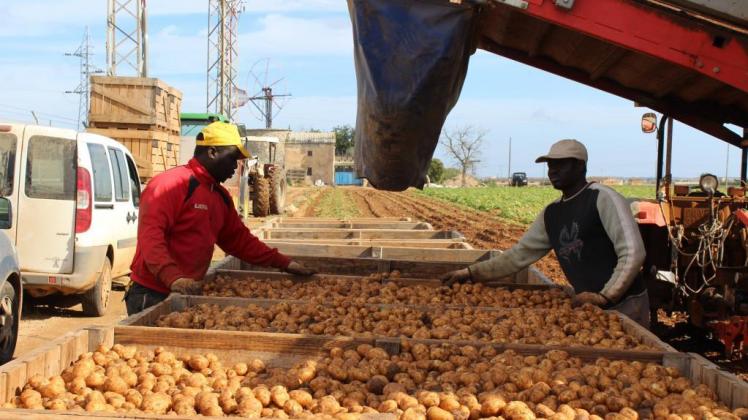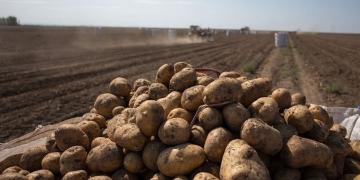India: Tuber trouble: Going to seed
Punjab’s Doaba belt produces India’s entire seed-potato requirement and its growers are hit by a fourth successive year of low prices.

“Alooan da dubya, Aloo hi taaruga” (if potato has drowned us, only it can save us) is a maxim that has stood the test of time for Harjinder Singh. That old formula, though, has seemingly collapsed for him and many other farmers of Doaba — the region in Punjab comprising the four districts of Jalandhar, Kapurthala, Hoshiarpur and Nawanshahr, and which is also India’s seed-potato hub.
Advertising
Punjab accounts for hardly 5% of the country’s potato output. But it supplies practically the entire potatoes that farmers in other producing states — from Uttar Pradesh, West Bengal, Bihar and Gujarat to Madhya Pradesh, Maharashtra and Karnataka — use as fresh “seed”.
“We make money when they make money. When potato prices are good, these farmers buy seed from us. Otherwise, they use their own saved crop as seed, which would not yield as much and is also more disease-prone,” notes Harjinder, a seed-potato grower from Malliwal village in Jalandhar.
Potatoes are mostly propagated by vegetative methods; the “seeds” that farmers plant are the tubers, having nodes or “eyes” from which the stems (sprouts) grow into new plants. But for the Doaba belt’s seed-potato growers, 2019 looks set to be the fourth successive year of low demand and prices for their produce. These farmers sow their crop between mid-October and end-November, and harvest from mid-February to end-March. The harvested tubers are kept in the fields under the cover of paddy/wheat crop stubbles for 2-3 weeks. Once their peels get sufficiently hardened, they are, then, put in cold stores for sale through the year.
Advertising
“The seed-potatoes that I harvested in February-March 2016 fetched low prices. So did my crops in 2017 and 2018. I have just harvested this year’s crop and there are no signs of buyers this time around, too. Earlier, even if prices were bad for two years, the third year would definitely be excellent. This is the first time in my four decades of cultivating potatoes that I am seeing what could be a fourth bad year in a row,” says the 55-year-old Harjinder.
In an “excellent” year, if regular table potatoes fetch a price of Rs 8-15 per kg for the farmer, the corresponding realisations from seed tubers would range from Rs 18 to Rs 35, depending upon the variety. “In the last three years, I have been getting Rs 3.5-4/kg during August-November, which is the peak season for seed-potato sales. Only this February, I sold my last year’s crop at 70 paise per kg to a dealer supplying to gaushalas (cow shelters) in Rajasthan. I had to do it, in order to create space in my cold store for the new crop,” remarks Harjinder, who has reduced his potato area this season to 67 acres (25 own and remaining leased-in), from 150 acres in the previous few years.
LATEST VIDEOS
02:34
Amid boycott call for Chinese goods, local markets register low participation
Doaba farmers grow seed-potatoes of regular table as well as premium and low-sugar/processing-grade varieties such as Kufri Jyoti, Kufri Chipsona, Kufri Pukhraj, Badshah, Diamond, Chandramukhi and Sultana. Seed-potato yields are only 80-100 quintals per acre, as against 120-140 quintals for table varieties. Seed-potato cultivation is highly labour-intensive, as the size of the tubers have to be maintained at 45-55 mm — as opposed to 70-90 mm for table potatoes — by trimming the stalks above the ground after 70 days to prevent extra growth. Harvesting, stubble covering and grading, too, has to be done very carefully.
“Our cultivation expenses alone come to about Rs 6/kg, while post-harvest costs are another Rs 3. I must have lost over Rs 20 lakh in the last three years by selling at much below cost. Why can’t the government ensure a minimum price of Rs 15 for potato farmers, which would make it worthwhile for them to plant good seed material? When consumers are paying Rs 20-25/kg, why cannot this be possible?” asks Jaspreet Singh Aujla from Kapur Pind village of Jalandhar, who cultivates seed-potatoes on 25 acres, of which 22 are on leased land.
BEST OF EXPRESS
National male workforce shrinking, says labour report that Govt buried
Infra push leads to surge in bank credit, reverses 2-year trend
BJP’s Chhattisgarh plan: No tickets for MPs, those who lost state polls
Gurmail Singh from Dhadda Haripur village of Jalandhar’s Nokodar tehsil, like many others, kept huge stocks of seed-potatoes from his February-March 2018 crop for a whole year, waiting in vain for prices to improve. He finally sold 7,000 bags of 50 kg each at Rs 35/bag to a Rajasthan gaushala supplier — again only to replenish cold storage space. Yet, he has taken over 100 acres on lease, in addition to his own 25 acres, to grow seeds in the current season. His logic is largely founded on hope: “The market for this crop is unpredictable. There could be a sudden surge in demand and prices, which may dissolve all my losses at a single go. After all, if farmers need seed, only we can supply”.
Jagjit Singh (46), sarpanch (headman) of Lallian Khurd village in Jalandhar, blames the unprecedented stretch of low potato prices on demonetisation. “This whole business ran on cash. We used to get orders for seed to be planted in November from March itself. Traders would come from different states and make payment straight in cash. Today, neither are we getting any advance orders and nor are traders paying in cash. On the contrary, they want us to supply seed on credit,” claims Jagjit, who owns 60 acres and has cut down his overall seed-potato area from 125 to about 100 acres.
Punjab produces some 25 lakh tonnes of potatoes annually on one lakh hectares of area. Only 40% of it comprises table potatoes that are ready for harvest by end-December. The balance 60% is seed, with 95% or more of it being grown in the Doaba region lying between the Sutlej and Beas rivers. Jalandhar district alone is home to big branded seed-potato players such as Sangha Farms, Bhatti Agritech and JS Farms.
“Doaba is best suited for seed production not only because of the region’s deep sandy loam soils, but also due to the October-December period being relatively free of aphid attacks. In December, the leaves of the plants are cut and the tuber remains inside the earth, which further reduces the probability of virus infestation from outside,” explains Dr Raj Kumar, head of the Central Potato Research Institute’s regional station at Jalandhar.
Doaba’s potato growers, however, have clearly seen better days — and are now looking for a divine taranhar (saviour).
Fuente: https://indianexpress.com/article/india/tuber-trouble-going-to-seed-punjab-potato-farmers-5625350/






